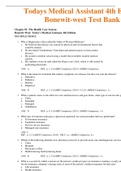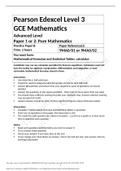Todays Medical Assistant 4th Edition Bonewit -west Test Bank Chapter 01: The Health Care System Bonewit -West: Today’s Medical Assistant, 4th Edition MULTIPLE CHOICE 1. Why is Hippocrates often called the father of Western Medicine? a. He believed that disease was caused by physical and environmental factors that could be studied. b. He developed “medications” from plant and animal sources to treat certain diseases. c. He created a medical school using a model that resembles modern medical schools. d. His students swore an oath called the Hippocratic Oath , which is still recited by graduating physicians. ANS: A REF: p. 2, CAAHEP Competency (2015); ABHES Competency: 2. What is the name for treatment that reduces symptoms of a disease, but does not cure the disease? a. Definitive b. Palliative c. Holistic d. Empirical ANS: B REF: p. 2, CAAHEP Competency (2015): V.C.10; ABHES Competency: 3.c. 3. When a patient comes to the office for care and then leaves and goes home, what type of care has the patient received? a. Clinic b. Extended c. Managed d. Ambulatory ANS: D REF: p. 6, CAAHEP Competency (2015); ABHES Competency: 1.b. 4. What type of insurance plan pays a physician separately for each procedure that was performed? a. Government insurance b. Capitation insurance c. Fee-for-service insurance d. Managed care insurance ANS: C REF: p. 3, CAAHEP Competency (2015): VIII.C.1.a.; ABHES Competency: 8.c. 5. Which of the following facilities now functions primarily to provide acute care and diagnostic services? a. Clinic b. Hospital c. Physician’s office d. Skilled nursing facility/nursing home ANS: B REF: p. 2, CAAHEP Competency (2015); ABHES Competency: 1.a. 6. What is a system by which a person (or the person’s employer) pays an insurance company a yearly amount of money in exchange for the insurance company’s paying some or most of the person’s medical expenses for that year? a. Life insurance b. Health insurance c. Capitation d. Formulary ANS: B REF: p. 3, CAAHEP Competency (2015): VIII.C.1.a.; ABHES Competency: 8.c. 7. What trend in modern medicine encourages patients to become more responsible for their own care? a. Taking active steps to avoid duplication of services and medical errors b. Identifying all patients with name and date of birth before providing service c. Coaching patients to make dietary changes, stop smoking, and exercise d. Treating conditions as outpatients to avoid hospitalization ANS: C REF: p. 2, CAAHEP Competency (2015): V.C.6.a.; ABHES Competency: 9.h. 8. The insurance plan called is designed to provide health insurance for low -income people. a. Medicaid b. Medicare c. Social Security d. TRICARE ANS: A REF: p. 5, CAAHEP Competency (2015): VIII.C.1.a.; ABHES Competency: 8.c. 9. What is the federal insurance plan that provides health insurance for the elderly, the disabled, and those with end -stage kidney disease? a. Medicaid b. Medicare c. TRICARE d. Managed Care ANS: B REF: p. 5, CAAHEP Competency (2015): VIII.C.1.a.; ABHES Competency: 8.c. 10. What is the current name for the health insurance plan for dependent spouses and children of active -duty military personnel? a. Medicaid b. Medicare c. TRICARE d. CHAMPVA ANS: C REF: p. 5, CAAHEP Competency (2015): VIII.C.1.a.; ABHES Competency: 8.c. 11. What type of health care encourages regular checkups, immunizations, and well -child visits? a. Acute care b. Conservative care c. Diagnostic care d. Routine care ANS: D REF: p. 6, CAAHEP Competency (2015): VIII.C.1.a.; ABHES Competency: 8.c. 12. What is utilization review? a. A process to determine whether health care is medically necessary b. A means to determine how much patients should pay for insurance c. Collection of statistics about the number of cases of specific diseases d. The systematic study of surgical t echniques ANS: A REF: p. 6, CAAHEP Competency (2015): VIII.C.1.a.; ABHES Competency: 8.c. 13. Which of the following was included in the original model for health maintenance organizations (HMOs)? a. A network of physicians in the community b. Payment only for visits resulting from illness or disease c. Full-service clinics in which the physicians were employees d. Allowing patient to obtain services at all hospitals in a given geographic area ANS: C REF: p. 6, CAAHEP Competency (2015): VIII.C.1.a.; ABHES Competency: 8.c. 14. What is it called when a physician receives one monthly fee from the insurance company for each subscriber in his or her practice? a. Fee-for-service b. Indemnity c. Incentive reimbursement d. Capitation ANS: D REF: p. 6, CAAHEP Competency (2015): VIII.C.1.a.; ABHES Compet ency: 8.c. 15. What is the name for an insurance plan’s list of approved medications? a. Formulary b. Prescription c. Premium d. Generic ANS: A REF: p. 6, CAAHEP Competency (2015): VIII.C.1.a.; ABHES Competency: 8.c. 16. Which of the following occurs first when a patient is seen in the medical office? a. Laboratory testing b. Examination by the physician c. Referral d. Instructions for follow -up care ANS: B REF: p. 7, CAAHEP Competency (2015); ABHES Competency: 1.a. 17. When does a physician part icipate in a residency program? a. After completing medical school b. Immediately after completing 4 years of college (bachelor’s degree) c. Only after becoming board -certified d. At any time when it is convenient during his or her training ANS: A REF: p. 8, CAAHEP Competency (2015); ABHES Competency: 18. Which of the following health professionals can manage routine patient care? a. Physician b. Nurse practitioner c. Physician assistant d. All are correct ANS: D REF: p. 9, CAAHEP Competency (2015); ABHES Competency: 1.b. 19. What examination must a physician pass in orde r to obtain a state license to practice medicine? a. National Medical Licensing Examination (NMLE) b. National Board Certification Examination (NBCE) c. Physician Licensing Examination (PLE) d. United States Medical Licensing Examination (USMLE) ANS: D REF: p. 8, CAAH EP Competency (2015): X.C.5.; ABHES Competency: 1.b. 20. Which of the following is an important part of effective teamwork for the medical assistant? a. Discussing a patient’s symptoms with the physician before he or she makes a diagnosis b. Pointing out the mistakes of others whenever he or she notices them c. Communicating well with all staff in the medical office d. Deciding what diagnostic tests each patient needs ANS: C REF: p. 10, CAAHEP Competency (2015); ABHES Competency: 1.d. 21. Why should doorways in the medical office be at least 3 -feet wide? a. This is requir ed for employee safety by OSHA (Occupational Safety and Health Administration). b. This is required by the Americans with Disabilities Act so that patients in wheelchairs have access. c. This is required by the Clinical Laboratory Improvement Act (CLIA ’88). d. This is the minimum size requirement of most local boards of health. ANS: B REF: p. 10, CAAHEP Competency (2015): X.C.10.c.; ABHES Competency: 4.b. 22. Which of the following are not usually found in the waiting room of a physician’s office? a. Toys for children to play with b. Current magazines and/or brochures c. Patient gowns and drapes d. Chairs for patients and family members ANS: C REF: p. 10, CAAHEP Competency (2015); ABHES Competency: 8.e. 23. Which activities occur at the patient check -in window or counter? a. Patients hand in new patient information forms and health insurance cards. b. Patients describe their chief complaint and medical history. c. A patient’s height, weight, and blood pressure are m easured. d. All are correct. ANS: A REF: p. 11, CAAHEP Competency (2015): VIII.P.2.; ABHES Competency: 8.b. 24. Which law or government agency is primarily responsible for the regulation of laboratories and laboratory tests? a. Americans with Disabilities Act b. Clinical Laboratory Improvement Act (CLIA ’88) c. State Medical Practice Act d. Centers for Medicare and Medicaid Services (CMS) ANS: B REF: p. 11, CAAHEP Competency (2015): I.C.10; ABHES Competency: 4.b. 25. If the office uses paper medical records, where are medical records of patients who have been seen within the past year usual ly stored? a. In a medical records area near the reception area b. In the basement of the medical office building c. In an off -site medical record storage area that is within 2 miles of the office d. In a special medical records area of the nearest local hospital ANS: A REF: p. 12, CAAHEP Competency (2015): VI.C.6.c.; ABHES Competency: 8.a. 26. Where is patient billing usually performed? a. Almost all medical offices perform billing in a billing area within the office. b. Almost all medical offices have their billing performed at the nearest local hospital. c. Billing may be done in an individual office, in a centralized location for several offices, or by a private billing service. d. Billing is almost always performed by an out side agency located in another state or country. ANS: C REF: p. 12, CAAHEP Competency (2015): VII.C.5; ABHES Competency: 8.b. 27. Which of the following areas is found in almost every medical office? a. Surgical procedure room b. Trauma room c. Diagno stic testing room d. Examination room ANS: D REF: p. 10, CAAHEP Competency (2015); ABHES Competency: 8.e. 28. Which of the following best describes family medicine? a. Provides general medical care of children, adolescents, and adults. b. Treats patients for emergency conditions. c. Provides medical treatment to adults for conditions of various body systems. d. Specializes in the care of children and adolescents. ANS: A REF: p. 13, CAAHEP Competency (2015): I.C.9; ABHES Competency: 1.a. 29. What type of medical care is provided in a patient -centered medical home (PCMH)? a. Coordinated primary care b. Acute inpatient care c. Long -term residential care d. Emergency and urgent care ANS: A REF: p. 14, CAAHEP Competency (2015): VIII.C.4; ABHES Competency: 1.a. 30. Which type of primary care seeks to balance the structure and function of the body through manipulation of muscles and joints? a. Podiatry b. Osteopathy c. Pediatrics d. Gynecology ANS: B REF: p. 14, CAAHEP Competency (2015): I.C.9; ABHES Competency: 1.b. 31. Which of the following types of medical practice might include a pediatrician, an internist, a dermatologist, an allergist, a neurologist, and a general surgeon? a. Solo practice b. Family practice c. Closed -panel health maintenance organization (HMO) d. Dermatology g roup practice ANS: C REF: p. 15, CAAHEP Competency (2015); ABHES Competency: 32. Traditionally, what distinguished a clinic from other types of medical offices? a. Care was free or very low cost. b. A clinic was run by the federal government. c. Physicians shared equipment and personnel. d. Each physician saw only his or her own patients. ANS: A REF: p. 15, CAAHEP Competency (2015); ABHES Competency: 1.a. 33. Which of the following might be studied scientifically by the National Center for Complementary and Integrative Health? a. Acupuncture b. Biofeedback c. Massage therapy d. All are correct ANS: D REF: p. 16, CAAHEP Competency (2015); ABHES Competency: MATCHING Directions: Match each medical specialty with its definition. Not all of the definitions are used. a. Branch of medical practice that seeks to balance the structure and function of the body through manipulation of muscles and joints; given all privileges of t hose with MD degrees b. Specializes in conditions of the skin c. Provides anesthesia during surgery and other procedures d. Utilizes manipulative treatment of the spine and joints e. Provides general medical care of children and adolescents f. Treats those with allergies and problems of the immune system g. Treat disorders of the feet and ankles h. Specializes in the care of the ear, nose, and throat i. Treats adults and children for routine care and complaints j. Treatment of the internal organs of adults by other than surgical means k. Performs surgical treatment of the large intestine and rectum l. Specializes in surgical care of bone and joint injuries and disorders 1. Internal medicine 2. Family medicine 3. Osteopathy 4. Dermatology 5. Podiatry 6. Anesthesiology 7. Pediatrics





